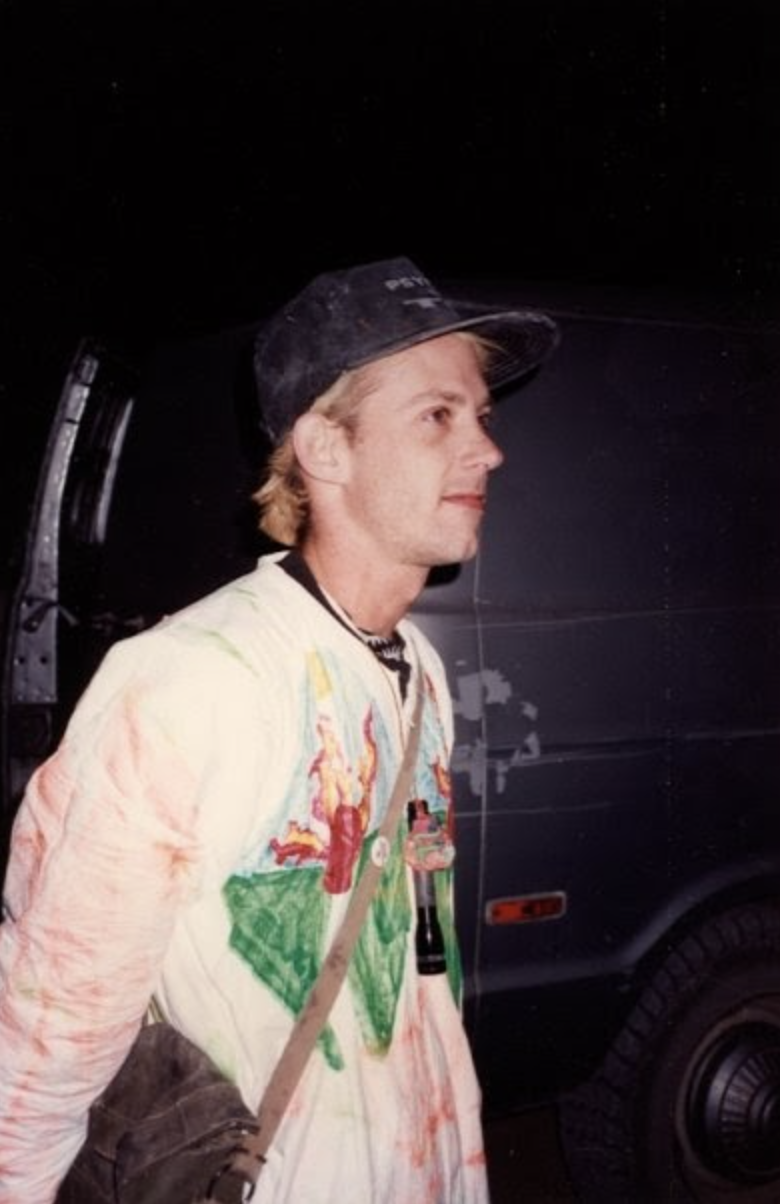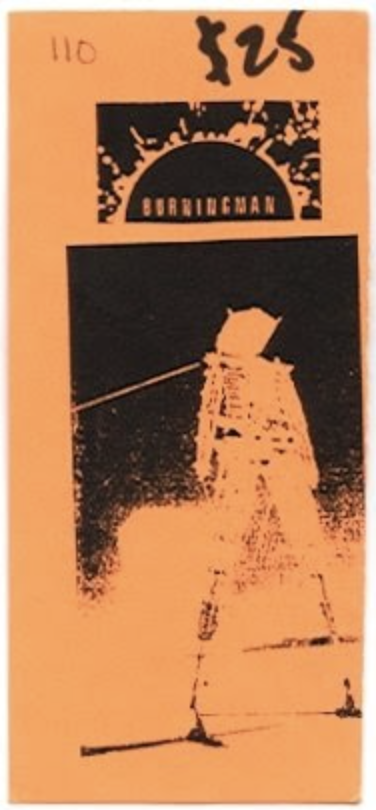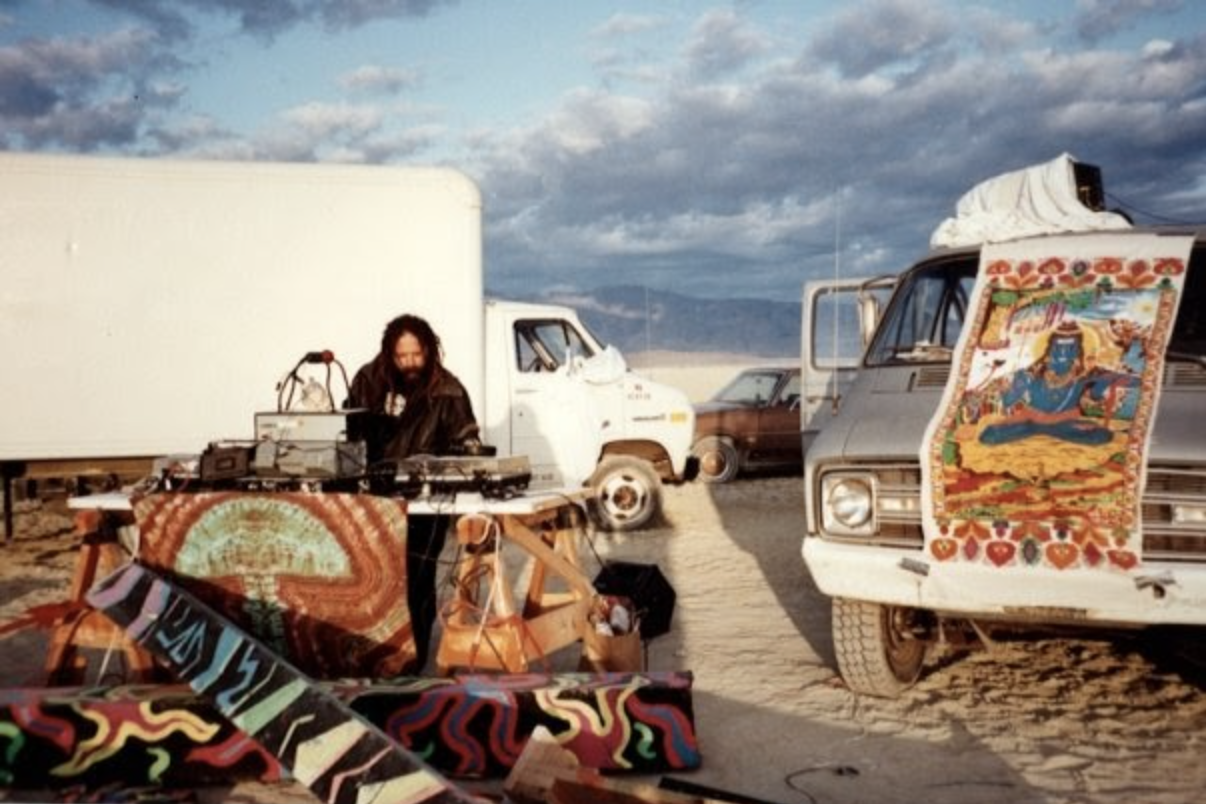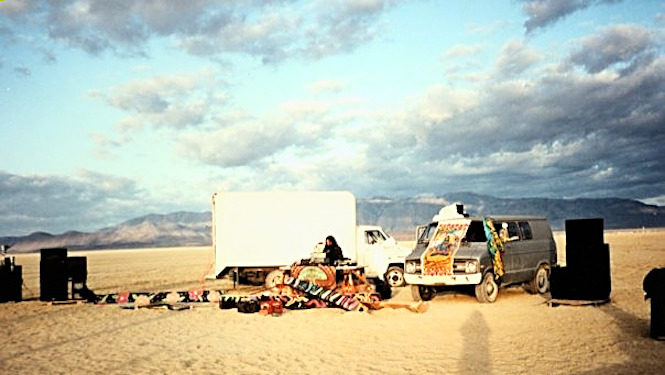In 1992, the first rave-style sound camp touched down in Black Rock City. And if you think it was well received, read on, intrepid Burner. Per the founders’ instructions, the sound camp Craig Ellenwood (aka DJ Niles or DJ Kraig) and Terbo Ted brought to the desert was placed one mile from Center Camp, speakers pointed away into the desert. Here’s the story of how it got there, straight from Craig and Ted, the DJs who led the charge to bring electronic music to Burning Man.

Craig: In 1992 I lived down south of Market in one of the first artist warehouse lofts in San Francisco. I was doing my laundry at a place called Brainwash, which was a laundromat. On the other side, they had a bar and a restaurant. I needed to write down somebody’s phone number, so I grabbed a flyer off the wall of flyers. It was for the Cacophony Society — just one page xeroxed copy, red paper. I looked through their agenda; it was a bunch of weirdos making a ruckus. I thought it was cool.
There was a little blurb at the bottom about a camping event over the Labor Day weekend in the desert — something called Burning Man. I asked around and nobody knew anything about the Cacophony Society, let alone Burning Man.
After a few weeks I just kind of gave up on trying to find out anything more about it.
I got a call from a friend a few weeks later who had mentioned it to someone whose roommate was in the Cacophony Society. And I got this guy’s phone number.
Craig called the guy and explained that he had been producing some of the Bay Area’s first underground raves out of a dilapidated 30-room Victorian mansion known as Mr. Floppy’s Flophouse. “We fuse technology, art and music,” Craig explained. “Would it be okay if I brought a sound system out there and set up a camp?”
Craig: I figured it would be a yes or no answer from that guy. And I was prepared to work him until I found my way in… At the time I also played with legendary industrial group Psychic TV, who had recently located from London to San Francisco.
I said, “Would it be easier if I could get Psychic TV to play out there?”
That was a good, hard, “Yes.” He said, “That would be a good place to begin. Nothing can be planned or done until I speak with Larry.”
“They’re not a bunch of peace-loving hippies out there.”
Craig: I remember that night very well. It was a foggy, cold, typical summer night in San Francisco. I drove up to Alamo Square, parked my car, walked up to his porch, rang his bell. I was a little bit nervous — a lot nervous, really.
Larry answered the door and my first impression of him was that he was also nervous. That made me crack some kind of joke as an icebreaker. I was about ready to launch into my pitch, and he’s like, “Wait, wait, wait, wait, wait, just stop.” He said, “I’m making tea. Follow me to the kitchen.”
So as we’re walking, he was struck by an idea and he just started talking. And after that there was no stopping the conversation. He stopped right underneath the doorway to the kitchen, put his arm up on the ledge of the doorway. And we just talked.
He asked me, “What is your idea? What are you looking to do?” I told him. I said that our methods may differ, but we’re both trying to achieve a change. I told him that combining our efforts could very well be a symbiotic thing.
Larry said, “Yes, but how I see it, it’s time for a change. People are too settled into how it’s been. And this could be a really good prank to pull.”
Then he eyed me in a very cautious way. He said, “They’re not all a bunch of peace-loving hippies out there. Be prepared for some resistance. There are some real hard-headed punks that aren’t going to like what we’re doing. So always have that in the back of your head. I’ve got a plan.”
He said all that. And then I realized he boiled off all the water in the kettle.

Nobody wanted to go camping in the desert…

Craig: Larry came by my place before the event. He gave me 50 tickets to sell, saying: “Don’t worry if you can’t sell all of them.”
Well, I couldn’t give these things away. Nobody wanted them. I sold a total of 20 tickets, all to my friends’ roommates … Nobody wanted to go camping in the desert six hours away from San Francisco on a perfectly good three-day weekend.
So my buddy Ted and I loaded up a truck with our sound equipment and decorations.
Ted: In ’92 we got there on the Thursday before the Burn and there were maybe 50 people there. The main camp was maybe 10 miles off the road from Gerlach. It was really hard to find. There was a red beacon on a 50-foot pole. The sun had gone down and we were having the hardest time finding it.
We spent our first night just camping in our tents, right by where Larry and Michael and the Man and all of them were. Then the next day we went out and camped a mile east of the Man, which is where they wanted us to have our camp so the sound wouldn’t bother people.
Before you imagine a massive, booming sound camp with flame effects, story-high speakers, and a DJ platform, take a minute to revise your expectations. We checked in with Ted to learn more about camp infrastructure and gear.
Ted: You know, there weren’t big camps at the time, there were no porta-potties, I think there was maybe one Airstream trailer and that was it — very different from how it is now. And I just remember it being this huge void, this expansive nothing. It was just very calm and quiet.
We had two tents, a truck, four really crappy speakers, some kind of table and workbench. We had some black lights, the generator, some turntables, a mixer, a couple of weird cardboard blacklight decorations — that was about it. We would just bring throwaway gear. And in fact that PA we had the first time, I believe it was like four Peavey speakers, which are low-grade crappy band speakers… we wouldn’t use them for a party in the city. They were that bad.
Video of Craig and Ted’s 1992 camp, captured by Cindy Stock. (Skip past the bongos to 22:57 to catch the raising of the Man! Jump to 37:30 for Goa Gil’s sunrise set.)
Craig: It sounded great out there. The acoustics bouncing off the mountains were amazing — the wind swirling the music around.
Not soon after, boy did we have some angry participants come out. They weren’t happy about it, and started yelling at us saying they’re trying to sleep. We were keeping them awake. We had people come out and try to slash the speakers. We had people try to pour sand in the generator. We didn’t have a lot of people come out and be supportive.
People would come by and dance for a little bit until their friends came and saw them. And then they’d scurry off back to camp like they were doing something wrong.
“Good for you. It’s too quiet out here.”
Craig: About 15 minutes later, four pickups rolled in really fast. A bunch of cowboys got out. I thought, “Oh great.” And they were local folks — cowboys right out of a western movie, a man and a woman. They came up and said they’d heard the music clear across the valley to where they lived.
The woman said, “I thought somebody was having a barn dance and they are, except there’s no barn. Good for you. It’s too quiet out here.” The man grabbed a cooler from the truck and handed us each a nice cold beer. And they went straight to the middle of the dance floor and started dancing. Nobody else was dancing. Just these cowboys.
They stayed all night long, got good and drunk. And any time anybody from the main camp would come and cause a problem they’d make a perimeter with their trucks. They were our bodyguards, our security arrangers, and our new friends.
One of them was the eighth best bull rider in the world. He called me up a month later. He was in town in San Francisco at the Cow Palace for a rodeo. He said I needed to take him to a rave.

“It’s morning. Time to put your visors on.”
Craig: In my first set that night in 1992, I split a 16-hour DJ set with DJ Lucas, my friend and a great DJ from Amsterdam. You know, nowadays DJs play for 45 minutes to an hour. Then, there were no other DJs so we could play as long as we wanted. And eight- to 10-hour sets were pretty much the norm.
Out of the eight hours I played, it was all improvised except for one track I knew I had to play as soon as the first rays of light came up on the horizon. It was a track that started with a sample of some astronauts talking in the Apollo spacecraft. As they came around the earth, the sun appeared.
The captain said, “It’s morning. Time to put your visors on.” I whipped out my shades, put them on and acted like nothing in particular at all had just happened. The reaction was visceral and every single person scrambled around in their bags for their own sunglasses. Lucas told me afterwards that out of the many, many times he heard that song played, none of them was more perfectly timed than that. I live for that kind of thing.
Ted: The sunrise after the Burn, I ran out maybe another mile east toward the sunrise and watched that sunrise in solitude, where the only nearest people are a mile away, they look like ants. I’m out there on the moon watching a sunrise, barely hearing the echoes of the music. That was pretty magical and spiritual.
That was just hard to explain… for someone from the city to have that much connection to the void or the earth or whatever was life-changing. You know, not ever being able to see the sunrise from a horizon, growing up in an area full of buildings, an urban environment, it was just very, very different. They talk about transformative experiences out there. That was definitely one that hit me really hard.
Ready to hear one of those early, early Black Rock City mixes? Dive into this DJ Kraig set from 1995. And while you’re here, give a listen to Terbo Ted’s Burning Man set from 1995.
Cover image of sunrise at BRC’s first sound camp, 1992 (Photo by Craig Ellenwood)


This is an amazing story. I can feel the “it’s morning, time to put your visors on” moment (by the way, what song is that?? I’m going to need it)
Report comment
<3 We've asked for the name of the track!
Report comment
Rotablade by Juno Reactor
https://youtu.be/cqb3628assw
The full mix is on my Mixcloud, btw. DJ Kraig
Thanks for the nice comment :)
Report comment
Burning man magic
Report comment
It’s a great place and I love reading about this place. your blog is definitely awesome as well, you have an unsurpassed workforce on your own website. good post keep it up.
geometry dash
Report comment
30 years ago next visit – holy shit –
Report comment
Thanks for this – and thanks for Mr. Floppy’s! I spent many good hours there. This piece holds some long threads for me … GPO was the person who first told me about Burning Man. And here we are today. Great story about the early days in the desert – I love the cowboys! The fact that so many people think Burning Man is a music festival has its roots right here.
Report comment
Badly wish I could go back in time to experience just ONE night at Mr. Floppy’s.
Report comment
Thanks for the great comment, made me smile :) Let’s reinvent the world now!
Report comment
This is a beautiful story – so glad to know more about this :)
Report comment
Awe. It really is.
Report comment
Cool Story!
Report comment
Yeah!!!
Report comment
Thanks for this historical journey……97 was my first year and I remember my first “RAVE” introduction was a camp called Braindrops I believe…….simply enlightening and so cool, you had to ask around where to find them….
Report comment
Wow, talk about getting the locals on your side. The magic of the contrast between quiet and noise has always been a favorite of mine at Burning Man ^-^
Report comment
This was an AWESOME story! The first rave at Burning Man was upheld and protected by local raver cowboys and champion bull riders? Are you kidding me? This could only happen at Burning Man! The playa has been full of Maigck since day 1! What a blessing!
Report comment
so true!
Report comment
A few years ago in the early morning hours at a club in Mumbai I met Goa Gil. After he finished his set he told me the story of playing on the playa in 1992. I had no idea there was photographic evidence! And Craig’s visit to Larry’s apartment sounds a lot like the first time I went there – pretty sure we talked in a doorway for at least an hour (I remember because I was illegally parked and thought a few times the parking ticket would be worth it because so many interesting things were flowing out of Larry’s head).
Report comment
What a great story. Looking forward to checking out the mixes.
Those small moments are everything.
Report comment
I love this so much — more old school tales. Almost without fail stories from the early days involve a cast of disparate characters who jump onboard a journey heading into an voyage they had no map for. “Goa GIl at Burning Man” and the 1996 Wired feature we the cheese that caught this playa mouse.
Report comment
Comments are closed.